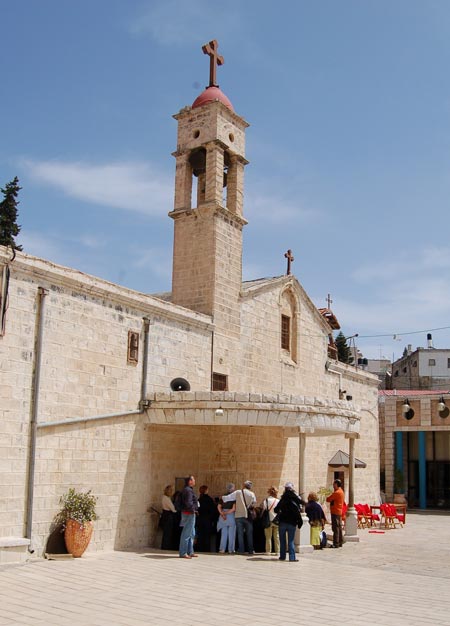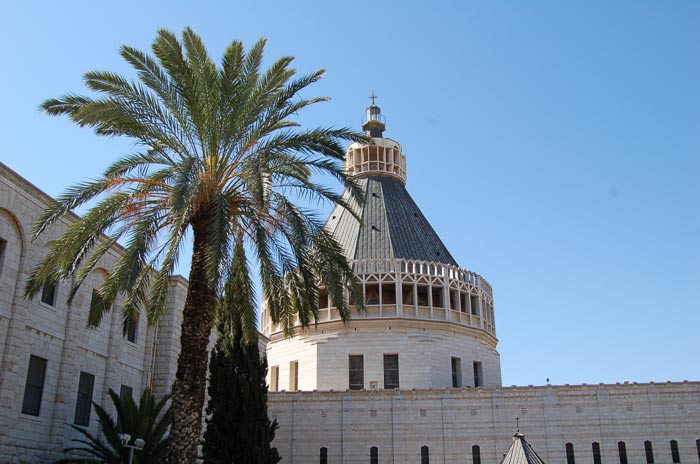
Greek Church of the Annunciation/St. Gabriel's Church, Mary's Well Square
ISRAEL PHOTOS IV -- Pilgrimage |
The Churches of the Annunciation

Greek Church of the Annunciation/St. Gabriel's Church, Mary's Well Square
Nazareth is the town where the Word was made flesh. According to Luke 1: In the sixth month, God sent the angel Gabriel to Nazareth, a town in Galilee, to a virgin pledged to be married to a man named Joseph, a descendant of David. The virgin's name was Mary. The angel went to her and said, "Greetings, you who are highly favored! The Lord is with you."
It is difficult to trust the traditions and writings that were handed down to us, as there seemed to be contradictions in some of them. The Greeks have built a church over a well that exposes a spring flowing out of the rock. Years ago the water was diverted through a culvert to a fountain not far from the church. The Greeks have borrowed a tradition from the apocryphal Gospel of James stating the angel appeared to Mary as she took a pitcher and went to fill it with water:
Palestine The Holy Land, As It Was and As It Is, by John Fulton, Philadelphia, 1900:
“Gabriel the Angel of Annunciation, who was sent of God to announce to the young Virgin that she should bear a Son who should be called the Son of the Highest and whose human name should be called JESUS (Luke 1:26-31). The Greeks maintain that it took place near the Fountain of the Virgin, and the Latin monks as positively assert that it was in a cave under their church."

This Roman Catholic Church of the Annunciation was built on the site of what may have been a first century house.
The Roman Catholics had a tradition that Mary received the good news about her being selected to bear a son while she was in the kitchen of her home.
According to archaeological evidence an early church was built at the site of the grotto during Byzantine times. By the testimony of Sir John it was in ruins during Medieval times. Early Travels in Palestine, H. G. Bohn (1796 – 1884) after Sir John Maudeville A.D. 1322:
“…now there is but a small village, and houses scattered here and there. It is not walled, but it is situated in a little valley, with hills all about…and there Gabriel greeted our Lady, saying, “Hail thou that art highly favoured, the Lord is with thee.” And this salutation was made on the site of a great altar of a fair church that stood there formerly, but it is now all down; and they have made a little receptacle, near a pillar of that church, to receive the offerings of pilgrims. And the Saracens keep that place full dearly, for the profit they have by it; and they are very wicked and cruel Saracens, and more spiteful than in any other place, and have destroyed all the churches.”
A View of the Holy Land, by George Thomson, Wheeling, WV, 1850:
“This convent is a neat and commodious building, inhabited by a dozen Latin fathers, whose life would be much more agreeable, if they were not in such continual fear of the Arabs. Having taken a small refreshment, (for we made no stay upon the road) we spend the remainder of the day in taking a view of Nazareth, which is at present only an inconsiderable village, situate on a high hill in the midst of a valley, almost encompassed with other mountains. From the convent we descend by ten or twelve steps into the church, which is built in a cave or grotto, supposed to be the place where the blessed Virgin received the salutation of the angel Gabriel, “Hail thou that are highly favored,” etc. This church is in the form of a cross, that part of which resembles the tree running directly into the cross, without any other roof over it than that of the natural rock; and the transverse part being built across the mouth of the grotto. Just at the section of the cross are two beautiful granite pillars, erected there by order of Helena, the mother of Constantine the Great, about a yard distant from each other; and are said to stand, one on the place where the angel stood to deliver the heavenly message, and the other where the Virgin was when she received it. Almost two feet of this last pillar has been broken away by the Turks just above its pedestal, in expectation of finding some treasure under it; and yet the upper part remains erect, or rather suspended from the roof; which not being easily accounted for, the friars tell us it is supported by a miracle.”
A Palestine Pilgrimage, Welch, Asheville, NC, 1922:
We visited the Church of Annunciation where the angel announced His coming birth. A marble altar with tablet containing the Latin inscription “Hic verbum caro factum est,” (Here the Word was made flesh) stands at one end of the chapel. On either side is a marble column, the one marking where the angel Gabriel stood in making the annunciation, the other where the Virgin stood in receiving it. Mary’s column is broken and suspends from the ceiling miraculously, you are told. Through a doorway we enter the Chapel of Joseph, and then we descend still deeper underground into Mary’s kitchen, which is nothing but an old underground cistern. The chimney is but the overhead opening though which the water entered and was drawn.
Nazareth Synagogue